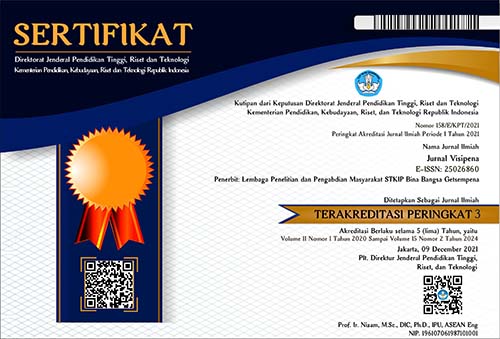HUBUNGAN ANTARA PERSEPSI ANAK TERHADAP KEMAMPUAN YANG DIMILIKI DAN KEMAMPUAN GERAK YANG SEBENARNYA
Abstract
To examine the relationship between perceived physical competence and actual motor skill competence of the first and the second years students of primary school at primary school number 31 an Banda Aceh municipality whose ages ranged from 5 to 7 year (N=30). All students individually completed the Harter and pike (1984) Pictorial Scale of Perceived Competence and Social Acceptance (PSPCSA) was measured by using the Test of Gross Motor Development (TGMD) Ulrich, 1985. Data collected from 30 students consist of 15 boys and 15 girls, whose average age X=6.7 year, standard deviation 0.41, the boys average age X=6.87 year and the girls average age X=6.12 year. The background of the students whose father work as government official and the rest unemployed family or work at private sector. Four separate ANOVA’s were conducted to determine gender differences in perceived physical competence and actual motor skill competence: locomotor, object control, and TGMD-Total. ANOVA documented that the boys and girls did not differ in perceived physical competence, F (1,57) = 0,427;P=0,52. The object control component of actual motor skill competence differed for gender F (1,57) = 10,91; P =0,001. Gender by locomotor competence, F (1,57) = 1,96; P = 0,17 and TGMD-Total F (1,57) = 0, 73; P = 0,40. The boys actual object control motor skill competence exceeded the girls. Correlation and regression models were used to examine the influence of actual motor skill competence and gender on perceived physical competence factors were not significantly correlated with perceived physical competence. These correlation were 0,00 for locomotor and 0, 25 for TGMD – Total competence. The object control sub scale was significantly correlated r = 0,33 with perceived physical competence F ( 1,58) = 4,17 ; p = 0,05. The correlation for actual motor skill competence was low to moderately correlated with perceived physical copentence.
Downloads
References
Bukowski, W. M, & Moore, D. (1980). Winners’ And Loser’s Attribution For Success And Failure In A Series Of
Athletic Events. Journal of Sport Psycholigy, 2, 195-210.
Goodway-Shiebler, J.D. (1994). The Effect Of A Motor Skill Intervention On The Fundamental Motor Skill And Sustained Activity Of African-American Preschoolers Who Are At Risk. Unpublished doctoral dissertation, Michigan State University, East langsing
Harter, S (1978). Effectence Motivation Reconsidered: Toward A Developmental, model. Human Development, 21, 34-64.
Harter, S. (1981). The Depelopment Of Competence Motivation In The Mastery Of Cognitive And Physical Skills: Is There Still A Place For Joy? In G.C Robert & D.M Landers (Eds), Psychology of motor Behaviour and sport, 1980. Greenwich, CT : JAI Press, pp. 3-29.
Harter, S. (1982) The Perceived Competence Scale For Children. Child Development, 53,87-97.
Harter, S. & Connell, J. (1984). A Model Of The Relation Ship Among Children’s Academic Achidemic Achievement And Their Self-Perceptions Of Competence, Control, And Motivation Orientation. In J.G. Nicholls (Ed). The development of achievement motivation. Greenwich, CT: JAI Press. Pp. 219-250.
Harter, S, & pike, R, (1984). The Pictorial Scale Of Perceived Competence And Social Acceptance And Social Acceptance For Young Children. Child Development, 55.1969-1982.
Overby, L. Y., branta, C., Goodway,J., & Smith, J. (1994). The relationship of parental attitude of perceive competence, motor development and physical fitness of Al-Risk youth. Paper presented at the National Covention of the Allince for Health, Physical education, and Recreation, denver, CO, April 16.
Rudisil, M, E (1989). Influece Of Perceived Competence And Causal Dimensial Orientation On Expectations, Persintence And Performance During Perceived Failure. Research Quarterly for Exercise and Sport 60,166-175.
Rudisill, M, E, Mahar, M, & Meaney, K.S (1993). The relationship betweenyoung children’s perceived and actual motor skill competence. Perceptual and motor Skills, 53,186-192.
Ulrich, B. D (1985). Test Of Gross Motor Development. Austin, Texas Pro.Edt.
Ulrich, B, D (1987). Perceptions Of Physical Competence, Motor Competence, And Participation In Organized Sport: Their Interrelationships In Young Chidren. Research Qurterly, 58,57-67.
Weiss, M, R. (1987). Self-Esteem And Achievement In Children’s Sport And Physical Activity. In D. Gould & M.R.
Weiss (Eds), Advences in pediatric sciences. Vol.. 2. Champaign, IL: Human kinectics, pp. 87-119.
Weiss, M.R. & Horn, T.S. (1990). The Relation Bet Ween Children’s Accuracy Estimates Of Their Physical Competence And Achievement Related Characteristic. Research Quarterly for Exercise and Sport. 61, 250-258.




















